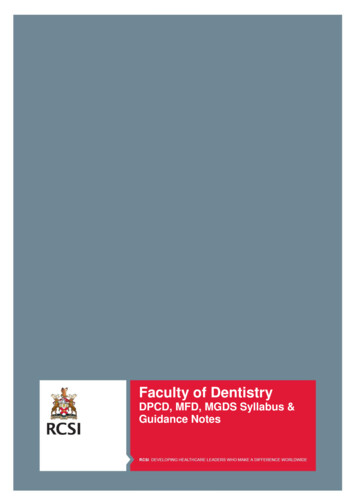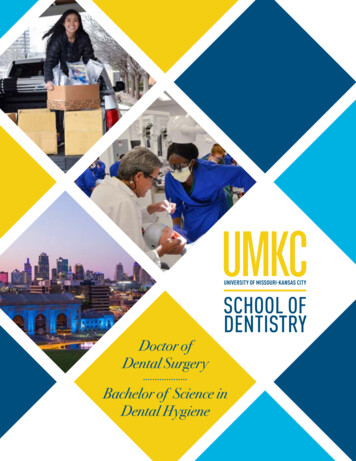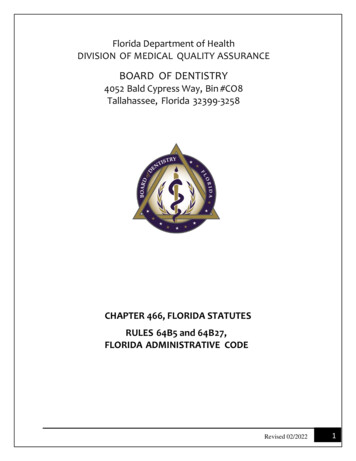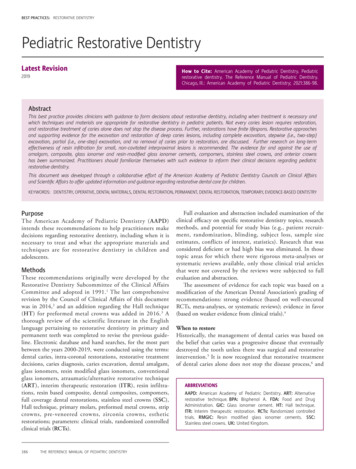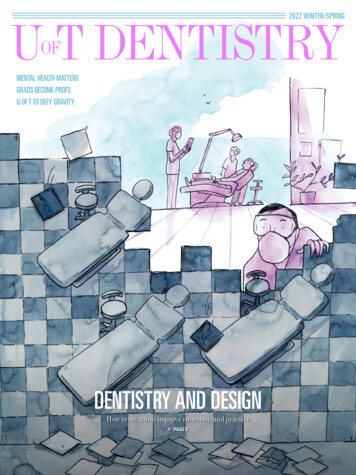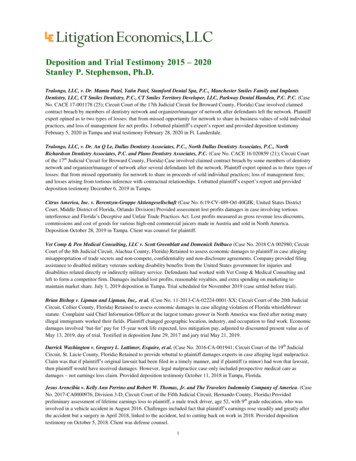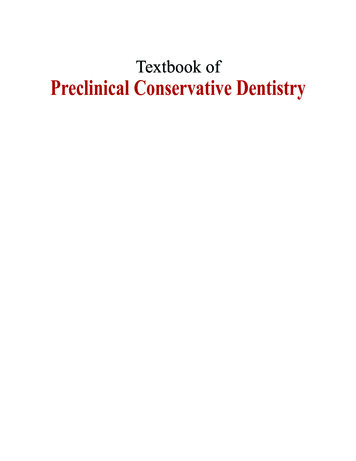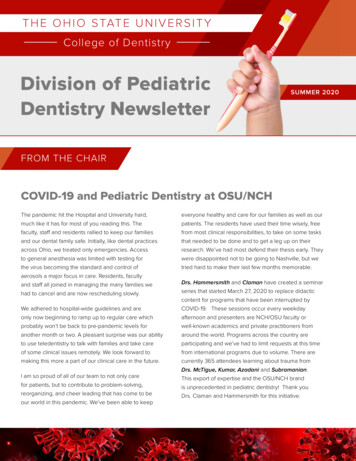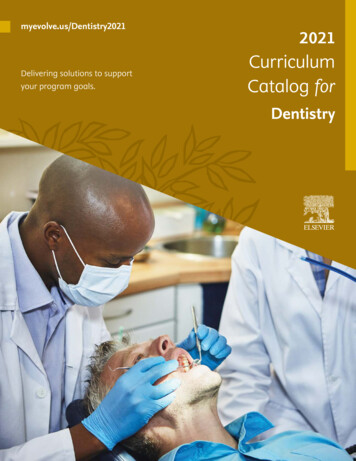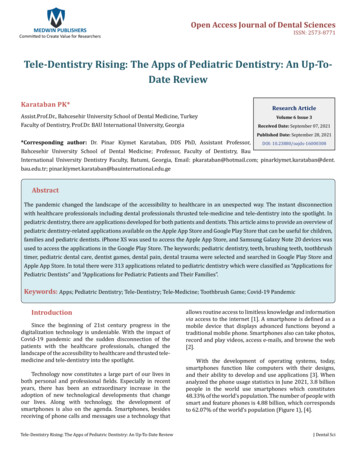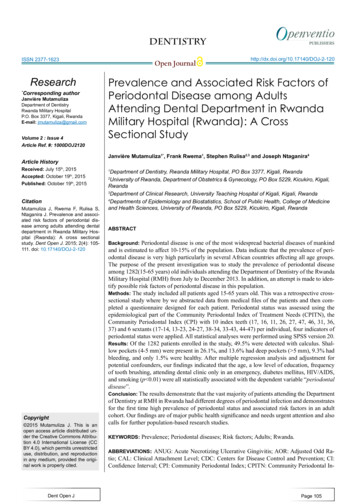
Transcription
DENTISTRYISSN 2377-1623Research*Corresponding authorJanvière MutamulizaDepartment of DentistryRwanda Military HospitalP.O. Box 3377, Kigali, RwandaE-mail: jmutamuliza@gmail.comVolume 2 : Issue 4Article Ref. #: 1000DOJ2120Article HistoryReceived: July 15th, 2015Accepted: October 19th, 2015Published: October 19th, 2015CitationMutamuliza J, Rwema F, Rulisa S,Ntaganira J. Prevalence and associated risk factors of periodontal disease among adults attending dentaldepartment in Rwanda Military Hospital (Rwanda): A cross sectionalstudy. Dent Open J. 2015; 2(4): 105111. doi: 10.17140/DOJ-2-120Copyright 2015 Mutamuliza J. This is anopen access article distributed under the Creative Commons Attribution 4.0 International License (CCBY 4.0), which permits unrestricteduse, distribution, and reproductionin any medium, provided the original work is properly cited.Dent Open JOpen nce and Associated Risk Factors ofPeriodontal Disease among AdultsAttending Dental Department in RwandaMilitary Hospital (Rwanda): A CrossSectional StudyJanvière Mutamuliza1*, Frank Rwema1, Stephen Rulisa2,3 and Joseph Ntaganira4Department of Dentistry, Rwanda Military Hospital, PO Box 3377, Kigali, RwandaUniversity of Rwanda, Department of Obstetrics & Gynecology, PO Box 5229, Kicukiro, Kigali,Rwanda3Department of Clinical Research, University Teaching Hospital of Kigali, Kigali, Rwanda4Departments of Epidemiology and Biostatistics, School of Public Health, College of Medicineand Health Sciences, University of Rwanda, PO Box 5229, Kicukiro, Kigali, Rwanda12ABSTRACTBackground: Periodontal disease is one of the most widespread bacterial diseases of mankindand is estimated to affect 10-15% of the population. Data indicate that the prevalence of periodontal disease is very high particularly in several African countries affecting all age groups.The purpose of the present investigation was to study the prevalence of periodontal diseaseamong 1282(15-65 years) old individuals attending the Department of Dentistry of the RwandaMilitary Hospital (RMH) from July to December 2013. In addition, an attempt is made to identify possible risk factors of periodontal disease in this population.Methods: The study included all patients aged 15-65 years old. This was a retrospective crosssectional study where by we abstracted data from medical files of the patients and then completed a questionnaire designed for each patient. Periodontal status was assessed using theepidemiological part of the Community Periodontal Index of Treatment Needs (CPITN), theCommunity Periodontal Index (CPI) with 10 index teeth (17, 16, 11, 26, 27, 47, 46, 31, 36,37) and 6 sextants (17-14, 13-23, 24-27, 38-34, 33-43, 44-47) per individual, four indicators ofperiodontal status were applied. All statistical analyses were performed using SPSS version 20.Results: Of the 1282 patients enrolled in the study, 49.5% were detected with calculus. Shallow pockets (4-5 mm) were present in 26.1%, and 13.6% had deep pockets ( 5 mm), 9.3% hadbleeding, and only 1.5% were healthy. After multiple regression analysis and adjustment forpotential confounders, our findings indicated that the age, a low level of education, frequencyof tooth brushing, attending dental clinic only in an emergency, diabetes mellitus, HIV/AIDS,and smoking (p 0.01) were all statistically associated with the dependent variable “periodontaldisease”.Conclusion: The results demonstrate that the vast majority of patients attending the Departmentof Dentistry at RMH in Rwanda had different degrees of periodontal infection and demonstratesfor the first time high prevalence of periodontal status and associated risk factors in an adultcohort. Our findings are of major public health significance and needs urgent attention and alsocalls for further population-based research studies.KEYWORDS: Prevalence; Periodontal diseases; Risk factors; Adults; Rwanda.ABBREVIATIONS: ANUG: Acute Necrotizing Ulcerative Gingivitis; AOR: Adjusted Odd Ra-tio; CAL: Clinical Attachment Level; CDC: Centers for Disease Control and Prevention; CI:Confidence Interval; CPI: Community Periodontal Index; CPITN: Community Periodontal In-Page 105
DENTISTRYISSN 2377-1623Open Journaldex of Treatment Needs; DHS: Demographic and Health Survey; NHANES III: National Health and Nutrition ExaminationSurvey III; OR: Odd Ratio; RMH: Rwanda Military Hospital;SES: Socioeconomic status; WHO: World Health Organization;USA: United States of America; UR/CMHS/SPH: University ofRwanda, College of Medicine and Health Sciences, School ofPublic Health.http://dx.doi.org/10.17140/DOJ-2-120was undertaken to evaluate the periodontal status and their riskfactors in 15-65 year old individuals attending the Departmentof Dentistry of the Rwanda Military Hospital (RMH) at KicukiroDistrict, Rwanda. A total of 1282 adults aged of 15-65 who attended the Hospital for dental services from July to December2013 were included in the study.9-11DATA COLLECTIONBACKGROUNDPeriodontal disease is an inflammatory disease that affects the soft and hard structures that support the teeth and is aleading cause of connective tissue attachment and tooth loss inolder adults.1 They are the most common chronic diseases affecting people of all ages worldwide. However, the severe formsof the disease are more pronounced in older individuals primarily due to prolonged exposure to risk factors.2 Several methodshave been developed to study the distribution of periodontaldiseases in a population. From the epidemiological and clinicaldata, it is clear that the severity of periodontal disease can becategorized as mild, moderate, or severe on the basis of multiplemeasurements of periodontal pocket depth, attachment loss, andgingival inflammation around teeth.3 Additionally, data fromlarge epidemiological studies indicate in some populations periodontal disease is more prevalent in males than in females andit worsens with increasing age.4,5 One of the major risk factorsof periodontal diseases is considered to be poor oral hygiene.5The most widely accepted methods for controlling periodontaldiseases and the associated conditions are personally and professionally applied mechanical oral hygiene measures.6,7Severe periodontal disease can be associated with othersystemic diseases, for example, diabetes mellitus, HIV infection,adverse pregnancy outcomes, cardiovascular diseases, certaintypes of leukemia, neutropenias and genetic disorders. Furthermore, some systemic diseases have oral manifestations whichincrease the risk of oral disease, which in turn is a risk factor fora number of general health conditions.5,8 With such a relationship between oral health and general health, there is a strong reason to prevent and control periodontal diseases, to do otherwisewould be irresponsible and unethical.To date, there is no information on the prevalence andrisk factors of periodontal diseases in Rwanda. Such data areimportant to identify people at high risk for periodontal diseaseand undertake strategic planning for preventive and therapeuticprograms. Against this background, the present study has beendesigned to study the prevalence of periodontal diseases andassociated risk factors including the age, gender, frequency oftooth brushing, and smoking in an adult population seeking dental services in Rwanda Military Hospital, Kigali City, Rwanda.The required information for each patient was abstracted from their medical files and then completed using a questionnaire designed for each patient. The questionnaire was composed of 4 parts: demographic characteristics (sex, date of birth,educational level and occupation); oral health behaviours (oralhygiene aids used, use of toothpaste, frequency of tooth brushingand flossing, current smoker, frequency of smoking, preventivedental visits and other aspects of care that might influence theparticipant’s oral health); systemic diseases and other conditionsrelated to periodontal diseases and finally, periodontal condition.Community periodontal index (CPI) of community periodontalindex of treatment need (CPITN) was used to record the periodontal status. Periodontal status was assessed using the epidemiological part of the CPITN, the CPI12,13 with 10 index teeth(17, 16, 11, 26, 27, 47, 46, 31, 36, 37) and 6 sextants (17-14,1323, 24-27, 38-34, 33-43, 44-47) per individual, four indicators ofperiodontal status were recorded.When two indexed teeth were considered in a sextant,the tooth with the highest score was recorded. Each indexedtooth was scored on 2 sites (buccal and lingual) and each sextant was scored according to its highest CPI score. If no indexedtooth was present in a sextant, all the remaining teeth in thatsextant were examined and the highest score was recorded as thescore for that sextant. The overall CPI score of the participantrepresented the value of the highest recorded code for that individual. A patient was considered as having periodontitis whenhe/she was classified as having CPI to 3.STATISTICAL METHODSStatistical analysis was performed using statisticalpackage for social sciences (SPSS version 20). Cross tabulation, chi square statistics, logistic regression analyses was usedfor statistical analysis at 5% level of significance. The variableswere age, gender, education level, occupation, use of toothpaste,frequency of tooth brushing, frequency of tooth-flossing, dentaloffice attendance, variables related to conditions known to belinked to periodontal diseases and variables related to smokingstatus of the patient. These variables were compared with theCPI codes.ETHICAL CONSIDERATIONSMETHODSThis retrospective, cross-sectional, descriptive studyDent Open JPermission and ethical clearance was sought from theInstitutional Review Board of the University of Rwanda, CollegePage 106
DENTISTRYISSN 2377-1623http://dx.doi.org/10.17140/DOJ-2-120Open Journalof Medicine and Health Sciences, School of Public Health (UR/CMHS/SPH). Approval reference number was 017/UR/CMHS/SPH/2014. The UR/CMHS/SPH Institutional Review Board isoperating under the Rwanda National Ethics Committee (FWAAssurance No: 00001973; IRB 00001497 of IORG 0001100).This study was based on hospital records.those who never smoked comprised 108(9.5%) of the study population. The vast majority 1257(98%) were documented as notundergoing orthodontic treatment. Of the 1282 adults enrolledin the study, the majority, 49.5% were detected with calculusfollowed by shallow pockets (4-5 mm) 26.1%; 13.6% had deeppockets, 9.3% had bleeding, and only 1.5% were healthy as it isdemonstrated in Table 4.RESULTSOf the 1282 adults who participated in this study,588(45.9%) were females and 694(54.1%) were males.773(60.3%) were in the age group of 15-34 years and 509(39.7%)35-65 years. 173(13.5%) were illiterate or had primary schoollevel of education while 1109(86.5%) had secondary oruniversity level of education; 511(39.9%) were unemployedand 771(60.1%) were employed (Table 1). All patients enrolledin the study were documented as using a toothbrush. In termsof frequency of tooth-brushing, more than half of the patientsenrolled in the study (69.7%) were reported as, brushing onceper day, 349(27.2%) were reported as brushing twice or morea day and 39(3%) were brushing their teeth irregularly. Thevast majority of the patients numbering at 1280(99.8%) weredocumented using dome form odd toothpaste. Of 1256 patients98 percent never used dental floss.VariablesNumber%Variables393.0Once per dayIrregular89469.7Twice or more a day34927.2Yes128099.8No20.2125698.0221.7Use of toothpasteTooth-flossingNeverIrregularOnce per day30.2Twice or more a day10.1121794.9655.1Number%Yes252No125798Dental Office AttendanceEmergency onlyPreventive77360.335-65 years old50939.7Table 2: Oral health behaviour (N erate or primary school17313.5Secondary school/University110986.5Orthodontic treatmentEducation 7160.1Dent Open JYes1078.3No117591.7DiabetesTable 1: Socio-demographic characteristics of the study population (N 1282).Only 22(1.7%) reported were irregular users of dentalfloss, 3(0.2%) were using dental floss once per day. A single individual (0.1%) was using dental floss twice or more a day. As perdental office attendance, 1217 patients (94.9%) reported attending when there is an emergency dental situation while 65(5.1%)were attending the dental department for preventive purposes(Table 2). The prevalance of conditions that impact on the pathogenesis is of periodontal diseases are shown in Table 3. Accordingly, a small proportion of patients, 107(8.3%) were pregnant,107(8.3%) were documented as diabetic patients, 104(8.1%)were living with HIV/AIDS and 23(1.8%) suffered from different forms of cancer. As for the smoking status of the participants,%Tooth-brushingAge15-34 years /AIDSCancerYes231.8No125998.2Ever smoked1089.5%Never smoked117491.5%Smoking StatusTable 3: Distribution of clinical conditions known to be related to Periodontal Diseases (N 1282).Page 107
DENTISTRYISSN en JournalVariablesNumber%0Healthy gingival191.51Bleeding on gentle probing1209.32Calculus at any supra or sub gingival site63549.53Shallow pocket (4-5 mm)33426.14Deep pocket (6 mm or more)17413.6hand low level of education, irregular tooth brushing, attendingdental clinic only in an emergency situation, diabetes mellitus,HIV/AIDS and smoking were also associated with periodontaldiseases.DISCUSSIONTable 4: Distribution of Periodontal Condition (N 1282).In the logistic regression (full and reduced model)shown in Table 5, patient between 35-65 years old were 11.421times more likely to develop periodontal diseases. On the otherThe purpose of this study was to determine the prevalence of periodontal disease among individuals aged between15-65 years old who attend dental clinic in Rwanda MilitaryHospital. In our study, one of the most frequently observed condition was calculus at any supra or sub gingival site (49.5%)followed by shallow pockets of 4-5 mm (26.1%). Deep pocketsFull modelFactorsReduced modelPrevalenceOR95% C.I.P valueAOR95% C.I.p value1. Socio-demographic characteristicsAge15-34 years old15.9%135-65 years old75.6%11.440Illiterate or primary school69.9%1Secondary school and Irregular user92.3%1Regular 0.011-0.064)0.000**11.421Education level10.358Occupation12.042Oral health behaviour characteristicsToothbrushing1Dental Office Attendance2. Clinical conditions known to be related to Periodontal 5%0.327Yes93.3%1No34.9%0.027Patients with smoking history90.7%1Patients without smoking S10.1463. Smoking statusSmoking status1(0.071-0.319)0.000**0.146Table 5: Predictors of periodontal diseases.Dent Open JPage 108
DENTISTRYISSN 2377-1623Open Journalof more than 6 mm were found in 13.6% of the subjects. Bleeding on gentle probing was found in only 9.4% of the populationsurveyed. Only 1.5% had healthy periodontium (Table 4). Thesefindings are not surprising as most of the cohort were nit attending to regular oral hygiene measures.The high prevalence of gingivitis (58.9%) and periodontitis (39.6%) found in this study is similar to that of gingivitis (98.7%) reported in a similar study done in Morocco and inWest Africa (84.2%) respectively.14-17 The latter studies of Harleyand Floyd,14 Adegbembo and El-Nadeef,15 Kubota, et al.,16 indicate that the major problem in this geographic region as in manyother jurisdictions of the developing world is gingivitis and to alesser extent periodontal disease. Other studies, for instance inGambia, have also shown a much higher proportion (80%) ofparticipants in need of complex periodontal treatment.17 Interestingly in Uganda, 41% of the subjects in the age group below 25years, one of the major problems reported were Acute Necrotizing Gingivitis18 and early onset periodontitis (28.8%).Further in Kenya, where both the child and adult populations have been studied adults studied, aged 15-65 years, only20% of the surfaces had loss of attachment 4 mm.19 In Tanzania, in 1967, it had been reported from the Usambara Mountains, particularly from Bumbuli and Mayo villages that morethan 75% of the people over 20 years had different degrees ofperiodontal infection.20The risk factors for periodontal disease in our studypopulation were older age, low level of education, poor oral hygiene, the behaviour of attending dental clinic only when thepatient is sick, diabetes, HIV/AIDS and smoking.21-24 Therefore,some of these modifiable risk factors should be considered toimprove the oral health of these populations.The surface of calculus is always covered by a viablemicrobial plaque with periodontal pathogens, and therefore it isconsidered to be a secondary etiological factor for periodontaldisease.25 The proportion of study participants that exhibitedthese risk factors was 58.9% and therefore population-basedpreventive measures should be done as a priority.Our findings showed a high prevalence of periodontaldisease in diabetics compared with their peers without diabetes(90.7% versus 35%) and this difference was statistically significant (p 0.01). It is now known that periodontal disease is oftena complication of diabetes. Indeed, a recent meta-analysis of 23studies the authors concluded that the prevalence and severityof periodontal disease is greater in diabetics than non-diabetics.On the other hand, periodontitis contributes to poor metaboliccontrol in people with diabetes26-35 which can in turn place themat risk for diabetic complications. More studies are needed to explore fully the effects of periodontal diseases and their progressin diabetes patients.Dent Open s study shows that the oral hygiene status amongthe study population was very poor, and did not match the selfreported tooth brushing practices. The majority had plaque,calculus, gingival bleeding and a moderate periodontal probingpocket depth of 4-5 mm. In view of the potential associationof periodontal disease with systemic diseases (atherosclerosis,diabetes, HIV/AIDS, Leukemia, myocardial infarction, strokeand pregnancy) as documented in different studies, this currenthealth situation is of major public health significance and needsurgent attention. To conclude, our study for the first time hasprovided an insight into the periodontal status and risk factorsfor periodontal disease among adults aged between 15-65 yearsold in Rwanda. As such it provides valuable information to helpplan a full national study.COMPETING INTERESTSThe authors declare that they have no competing interests.AUTHOR’S CONTRIBUTIONSMutamuliza Janvière (MJ) designed the protocol in collaboration with Joseph Ntaganira (JN), developed the questionnaireand directed all steps of data collection in collaboration withRulisa Stephen (RS). Frank Rwema (FR) supervised all the datacollection, supervised data entry and cleaning. MJ carried outthe statistical analyses with support from JN and RS. MJ draftedthe manuscript; FR, RS and JN read and revised the text until afinal version, which was accepted by all authors.ACKNOWLEDGMENTThe authors wish to thank the administrative body and clinicalstaffs of Rwanda Military Hospital for their support.CONSENTIn this retrospective study, the written informed consent waswaived as the required information for each patient enrolled inthe study was abstracted from their medical files.REFERENCES1. Ranney RR. Classification of periodontal diseases. Periodontol 2000. 1993; 2: 13-25.2. Albandar JM. Global risk factors and risk indicators for periodontal diseases. Periodontology 2000. 2002; 29: 177-206. doi:10.1034/j.1600-0757.2002.290109.x3. Armitage GC. Classifying periodontal diseases -a long-standing dilemma. Periodontol 2000. 2002; 30: 9-23.Page 109
DENTISTRYISSN 2377-1623Open Journal4. Albandar JM, Brunelle JA, Kingman A. Destructive periodontal disease in adults 30 years of age and older in the UnitedStates, 1988-1994. J Periodontol. 1999; 70: 13-29. doi: 10.1902/jop.1999.70.1.135. Le CT, Boen JR. Health and Numbers: Basic BiostatisticalMethods. Chichester, UK: John Wiley; 1995.6. Gift HC. Social factors in oral health promotion. In: Schou L,Blinkhorn AS, eds. Oral health promotion. Oxford, UK: OxfordUniversity Press; 1993: 65-102.7. Axelsson P, Albandar JM, Rams TE. Prevention and controlof periodontal diseases in developing and industrialized nations.Periodontol 2000. 2002; 29: 235-246. doi: 10.1034/j.16000757.2002.290112.x8. Petersen PE. Global policy for improvement of oral healthin the 21st century-implications to oral health research of WorldHealth Assembly 2007, World Health Organization. Community Dent Oral Epidemiol. 2009; 37: 1-8. doi: 10.1111/j.16000528.2008.00448.x9. Moore PA, Weyant RJ, Mongelluzzo MB, et al. Type 1 diabetes mellitus and oral health: Assessment of tooth loss and edentulism. J Public Health Dent. 1998; 58: 135-142.10. Preferansow E, Gołebiewska M, Kulikowska-Bielaczyc E,Górska M. The assessment of periodontium in patients with uncontrolled diabetes. Adv Med Sci. 2006; 51(Suppl 1): 170-172.11. Selwitz RH, Pihlstrom BL. How to lower risk of developing diabetes and its complications: Recommendations for thepatient. J Am Dent Assoc. 2003; 134: 54S-58S.12. Omar SM, Pitts NB. Oral hygiene, gingivitis and periodontalstatus of Libyan school children. Community Dent Health. 1991;8: 329-333.13. Ainamo JJ, Barmes DD, Beagrie GG, Cutress TT, MartinJJ, Sardo-Infirri JJ. Development of the World Health Organization (WHO) community periodontal index of treatment needs(CPITN). International Dental Journal. 1982; 32(3): 281-291.14. Harley AF, Floyd PD. Prevalence of juvenile periodontitis in schoolchildren in Lagos, Nigeria. Community Dent OralEpidemiol. 1988; 16: 299-301. doi: 10.1111/j.1600-0528.1988.tb01780.x15. Adegbembo AO, El-Nadeef MA. National survey of periodontal status and treatment need among Nigerians. Int Dent J.1995; 45: 197-203.16. Kubota K, Watanabe H, Hollist NO, et al. Dental survey inNigeria. Part 4. Prevalence and severity of periodontal diseases.Dent Open Jhttp://dx.doi.org/10.17140/DOJ-2-120Bull Tokyo Med Dent Univ. 1988; 35: 11-17.17. Adegbembo AO, Adeyinka A, Danfillo IS, et al. Nationalpathfinder survey of periodontal status and treatment needs inThe Gambia. South Afr Dent J. 2000; 55: 151-157.18. Wandera M, Twa-Twa J. Baseline survey of oral health ofprimary and secondary school pupils in Uganda. Afr Health Sci.2003; 3: 19-22.19. Baelum V, Fejerskov O, Manji F. Periodontal diseases inadult Kenyans. J Clin Periodontol. 1988; 15: 445-452.20. Jacobson LE, Kreysler JV. Dental status of different agegroups in the Usambara mountains, Tanzania. East Afr Med J.1967; 44: 221-226.21. Petersen PE, Ogawa H. Strengthening the prevention of periodontal disease: The WHO approach. J Periodontol. 2005; 76:2187-2193.22. Kocher T, Schwahn C, Gesch D, et al. Risk determinantsof periodontal disease--an analysis of the study of health inPomerania (SHIP 0). J Clin Periodontol. 2005; 32: 59-67. doi:10.1111/j.1600-051X.2004.00629.x23. Corraini P, Baelum V, Pannuti CM, Pustiglioni AN, RomitoGA, Pustiglioni FE. Risk indicators for increased probing depthin an isolated population in Brazil. J Periodontol. 2008; 79:1726-1734. doi: 10.1902/jop.2008.07058624. Haubek D, Ennibi OK, Poulsen K, Vaeth M, Poulsen S,Kilian M. Risk of aggressive periodontitis in adolescent carriers of the JP2 clone of Aggregatibacter (Actinobacillus) actinomycetemcomitans in Morocco: A prospective longitudinalcohort study. Lancet. 2008; 371: 237-242. doi: 10.1016/S01406736(08)60135-X25. Ready D, D’Aiuto F, Spratt DA, Suvan J, Tonetti MS, Wilson M. Disease severity associated with 313 presence in subgingival plaque of Porphyromonas gingivalis, Aggregatibacteractinomycetemcomitans, and Tannerella forsythia, singly or incombination, as detected by nested multiplex PCR. J Clin Microbiol. 2008; 46: 3380-3383. doi: 10.1128/JCM.01007-0826. Sheiham A. Is the chemical prevention of gingivitis necessary to prevent severe periodontitis? Periodontol 2000. 1997;15: 15-24. doi: 10.1111/j.1600-0757.1997.tb00100.x27. Slots J. Herpesviruses, the missing link between gingivitisand periodontitis? J Int Acad Periodontol. 2004; 6: 113-119.28. Eke PI, Thornton-Evans G, Dye BA, Genco R. Advances insurveillance of periodontitis: The centers for disease control andprevention periodontal disease surveillance project. J Periodon-Page 110
DENTISTRYISSN 2377-1623Open Journalhttp://dx.doi.org/10.17140/DOJ-2-120tol. 2012; 1337-1342. doi: 10.1902/jop.2012.11067629. Cianciola LJ, Park BH, Bruck E, Mosovick L, Genco RJ.Prevalence of periodontal disease in insulin-dependent diabetesmellitus (juvenile diabetes). J Am Dent Assoc. 1982; 104: 653660. doi: 10.14219/jada.archive.1982.024030. Taylor GW, Burt BA, Becker MP. Non-insulin dependent diabetes mellitus and alveolar bone loss progression over 2 years.J Periodontol. 1998; 69: 76-83. doi: 10.1902/jop.1998.69.1.7631. Salvi GE, Kandylaki M, Troendle A, Persson GR, Lang NP.Experimental gingivitis in type 1 diabetics: A controlled clinicaland microbiological study. J Clin Periodontol. 2005; 32: 310316. doi: 10.1111/j.1600-051X.2005.00682.x32. Lalla E, Cheng B, Lal S, et al. Diabetes mellitus promotesperiodontal destruction in children. J Clin Periodontol. 2007;34: 294-298. doi: 10.1111/j.1600-051X.2007.01054.x33. Loe H. Periodontal disease: the sixth complication of diabetes mellitus. Diabetes Care. 1993; 16: 329-334. doi: 10.2337/diacare.16.1.32934. Khader YS, Dauod AS, El-Qaderi SS, Alkafajei A, BatayhaWQ. Periodontal status of diabetics compared with nondiabetics: A meta-analysis. J Diabetes Complications. 2006; 20: 5968. doi: 10.1016/j.jdiacomp.2005.05.00635. Taylor GW, Borgnakke WS. Periodontal disease: Associations with diabetes, glycemic control and complications. OralDis. 2008; 14: 191-203. doi: 10.1111/j.1601-0825.2008.01442.xDent Open JPage 111
4Departments of Epidemiology and Biostatistics, School of Public Health, College of Medicine and Health Sciences, University of Rwanda, PO Box 5229, Kicukiro, Kigali, Rwanda *Corresponding author Janvière Mutamuliza Department of Dentistry Rwanda Military Hospital P.O. Box 3377, Kigali, Rwanda E-mail: jmutamuliza@gmail.com Article History
